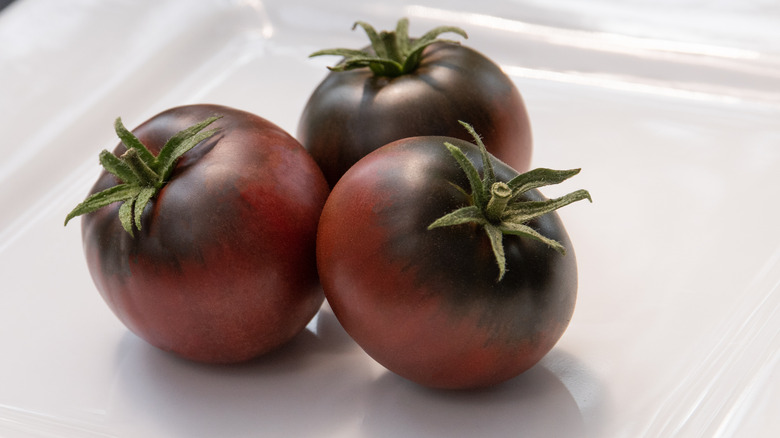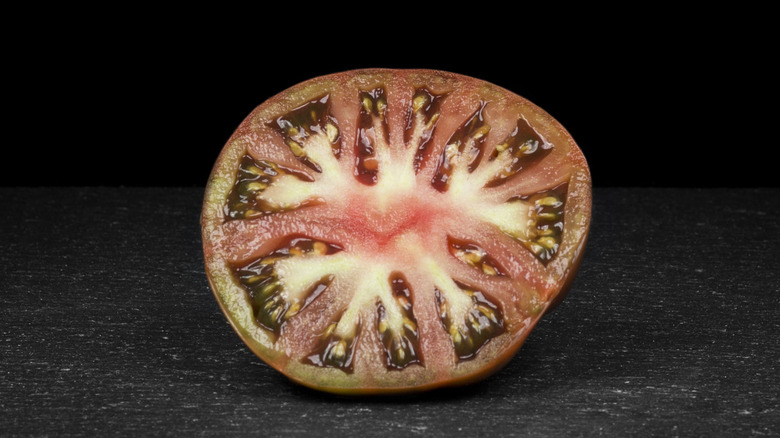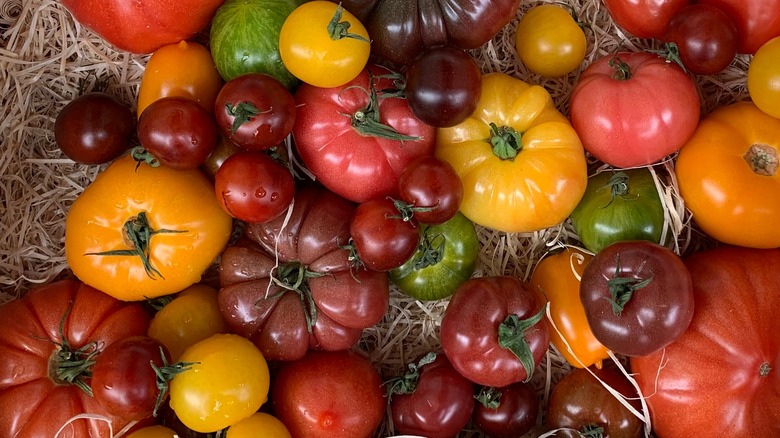The Scientific Reason Cherokee Purple Tomatoes Look So Funky
Let's get the obvious out of the way first: Cherokee Purple tomatoes are a bit strange. They're a variety of beefsteak tomatoes characterized by their large size and the fact that they're grown on indeterminate vines. That means that instead of a nice, compact plant that you might grow on your back porch, these tomatoes grow on vines that will just keep growing. That's necessary to support these huge tomatoes, and even among beefsteak tomatoes, Cherokee Purples are massive and will weigh in at up to a pound each.
Then, there's their most arguably unappetizing characteristic, which is the fact that they're colored like a rather fresh bruise. Still, that's proof that you shouldn't judge a book by its cover. These lumpy, strangely-colored tomatoes are lauded for their intensely sweet yet acidic flavor, and they're often said to have earthy, smoky overtones. Add in their thick skins, firm pulp, and their tendency to be incredibly juicy, and they just might be the perfect tomato.
But why in the world do they look like that? Many shoppers are familiar with the smooth red or yellow tomatoes that are more frequently seen in grocery stores, and it turns out that this funky heirloom tomato has the perfect mix of genetics to create a deliciously unique tomato.
Here's why Cherokee purple tomatoes have such a distinctive color
First, there's a little clarification that's necessary. If you look at a Cherokee Purple tomato, one of the first things you're likely to notice is that it's not quite as purple as the name suggests it should be. When these tomatoes are fully ripe, they could be described as having a skin color that's kind of like a dirty rose with splashes of green. It's inside where you see that somewhat unsettling color of a dark Purple bruise, and that's important.
You may have heard of a recently developed strain of purple tomatoes that is often compared to blueberries, as they both get their color from something called anthocyanin. Although you might see places repeating the idea that this is what's going on with Cherokee Purple tomatoes, it's not: They contain little anthocyanins in the pigments that give them their unique color.
Instead, Cherokee Purple tomatoes contain something called pheophytin. Pheophytin is brown, but that's only part of what's going on here. They also contain lycopene, which is red, and chlorophyll, which is green, along with a gene that causes them to have green-hued flesh and yellowish skin. Put all of those things together, and you get that unique purplish-brown, slightly greenish appearance of these funky tomatoes.
What's an heirloom tomato, and why are they called Cherokee purple?
What exactly are heirloom tomatoes, anyway? There is actually no set-in-stone definition of what makes an heirloom variety of tomato, but there are some general guidelines. Most agree that these are varieties that have not been hybridized or selectively bred for specific traits. They are often passed down through families and small-scale farms, and they've existed for a set amount of time. One of the most common markers is that they should pre-date World War II.
Today, Cherokee Purple tomatoes are widely available because of a tomato seed collector named Craig LeHoullier. He has dedicated his post-retirement life to preserving heirloom tomatoes, and in 1990, he got a packet of seeds and a story in the mail.
The story was from a Tennessee man who had gotten the seeds from a neighbor who had been raising them for several generations. They said that the tomatoes had originally been raised by local Cherokee, and when he grew them, the name became pretty obvious. LeHoullier was shocked at how good these tomatoes were and decided to try to introduce them to a wider market through commercial seed producers. One in particular — Southern Exposure Seed Exchange — took a gamble on them, and it almost didn't happen. Seed coordinator Ira Wallace told NPR, "If Craig hadn't said, 'This tomato is really amazing,' I doubt we would have tried it. It was an ugly tomato." And that? It's a crucial lesson in the importance of appearances.


